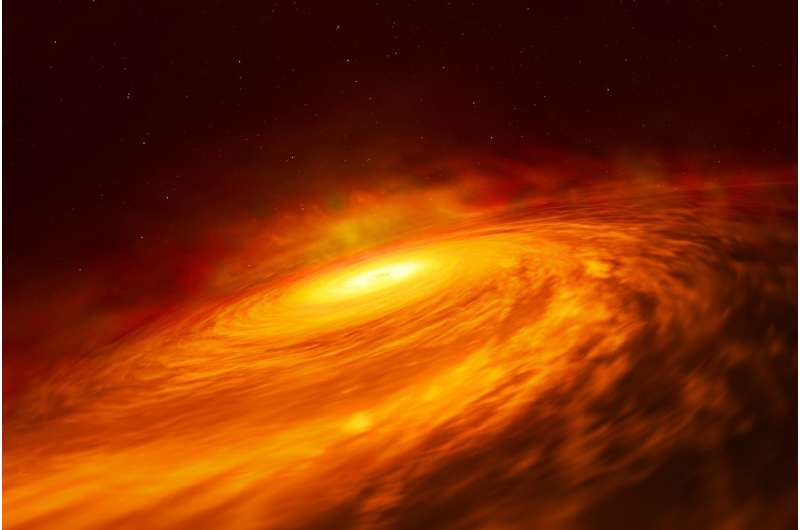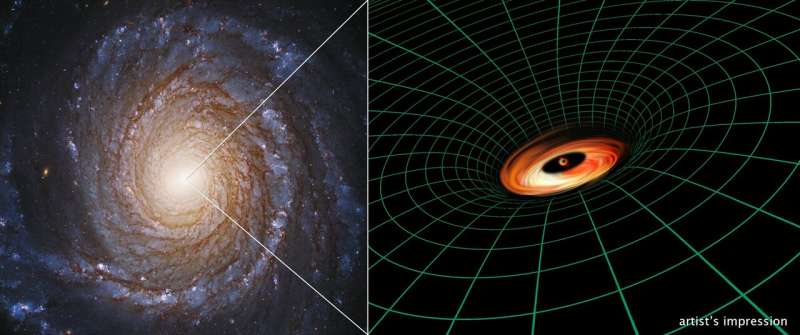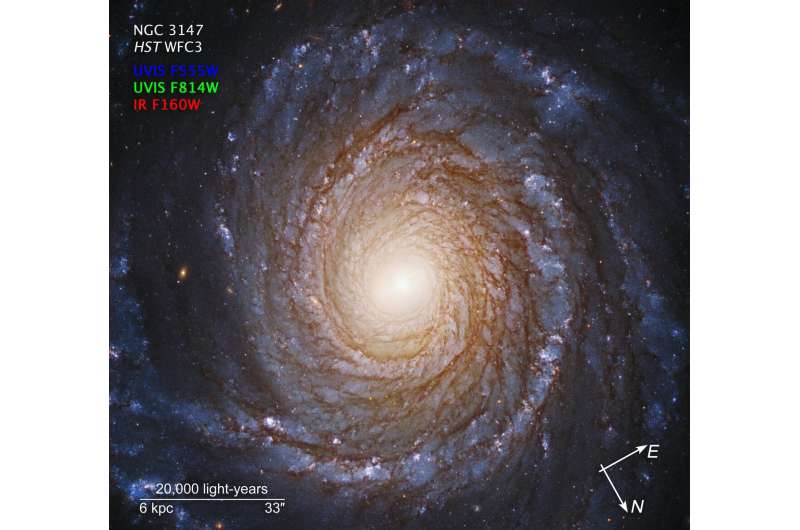Hubble discovers mysterious black hole disc

Astronomers using the NASA/ESA Hubble Space Telescope have observed an unexpected thin disc of material encircling a supermassive black hole at the heart of the spiral galaxy NGC 3147, located 130 million light-years away.
The presence of the black hole disc in such a low-luminosity active galaxy has astronomers surprised. Black holes in certain types of galaxies such as NGC 3147 are considered to be starving as there is insufficient gravitationally captured material to feed them regularly. It is therefore puzzling that there is a thin disc encircling a starving black hole that mimics the much larger discs found in extremely active galaxies.
Of particular interest, this disc of material circling the black hole offers a unique opportunity to test Albert Einstein's theories of relativity. The disc is so deeply embedded in the black hole's intense gravitational field that the light from the gas disc is altered, according to these theories, giving astronomers a unique peek at the dynamic processes close to a black hole.
"We've never seen the effects of both general and special relativity in visible light with this much clarity," said team member Marco Chiaberge of AURA for ESA, STScI and Johns Hopkins Univeristy.
The disc's material was measured by Hubble to be whirling around the black hole at more than 10% of the speed of light. At such extreme velocities, the gas appears to brighten as it travels toward Earth on one side, and dims as it speeds away from our planet on the other. This effect is known as relativistic beaming. Hubble's observations also show that the gas is embedded so deep in a gravitational well that light is struggling to escape, and therefore appears stretched to redder wavelengths. The black hole's mass is around 250 million times that of the Sun.

"This is an intriguing peek at a disc very close to a black hole, so close that the velocities and the intensity of the gravitational pull are affecting how we see the photons of light," explained the study's first author, Stefano Bianchi, of Università degli Studi Roma Tre in Italy.
In order to study the matter swirling deep inside this disc, the researchers used the Hubble Space Telescope Imaging Spectrograph (STIS) instrument. This diagnostic tool divides the light from an object into its many individual wavelengths to determine the object's speed, temperature, and other characteristics at very high precision. STIS was integral to effectively observing the low-luminosity region around the black hole, blocking out the galaxy's brilliant light.
The astronomers initially selected this galaxy to validate accepted models about lower-luminosity active galaxies: those with malnourished black holes. These models predict that discs of material should form when ample amounts of gas are trapped by a black hole's strong gravitational pull, subsequently emitting lots of light and producing a brilliant beacon called a quasar.

"The type of disc we see is a scaled-down quasar that we did not expect to exist," Bianchi explained. "It's the same type of disc we see in objects that are 1000 or even 100 000 times more luminous. The predictions of current models for very faint active galaxies clearly failed."
The team hopes to use Hubble to hunt for other very compact discs around low-luminosity black holes in similar active galaxies.
The team's paper will appear in the journal the Monthly Notices of the Royal Astronomical Society.
More information: Stefano Bianchi et al. HST unveils a compact mildly relativistic broad-line region in the candidate true type 2 NGC 3147, Monthly Notices of the Royal Astronomical Society: Letters (2019). DOI: 10.1093/mnrasl/slz080
Provided by ESA/Hubble Information Centre




















